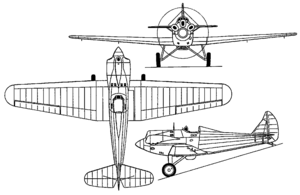IAR-14
| IAR-14 | |
|---|---|

|
|
| Type: | Fighter plane |
| Design country: | |
| Manufacturer: | |
| First flight: |
1933 |
| Commissioning: |
1934 |
| Production time: |
1933-1934 |
| Number of pieces: |
20th |
The IAR-14 was a Romanian fighter aircraft . It was developed by Intreprinderea Aeronautică Română in 1933 and used by the Romanian Air Force . The IAR-14 was based on a similar pattern, the IAR-12 .
history
The development of the IAR-14 began with the development of the previous model IAR-12 , which was designed by Elie Carafoli in the early 1930s and first flew in 1932. This type was a low-wing aircraft in mixed construction, which was powered by a 450 hp Lorraine-Dietrich 12 Eb W engine and was armed with two 7.7 mm machine guns from Vickers . The IAR-12, in turn, went back to the IAR-11 of 1930.
An improvement in the aerodynamics of the IAR-12 and an exchange of the engine for a V-engine Hispano-Suiza 12 Mc led to the successor type IAR-13 in 1934 , which competed with the Polish PZL P.11 for a tender by the Romanian Air Force for a new type of fighter . Since the Romanian military was more impressed by the seagull wing shape of the PZL P.11's structure than by the IAR low-wing aircraft, the contract ultimately went to the Polish competing sample, which IAR was also supposed to produce under license.
IAR has not given up the development of its own single-seater hunting vehicle. Once again, the aerodynamic properties of the IAR-13 have been improved by reducing the size of the main wings and redesigning the shape of the tail. In addition, the Lorraine-Dietrich 12Eb was used again. Although this engine was inferior to that of Hispano-Suiza in terms of performance, it had the advantage that it could be manufactured under license at IAR. The armament still consisted of the two 7.7 mm machine guns from Vickers.
The changes to the design of the type, now known as IAR-14, prompted the Romanian Air Force to order a series of 20 pieces for trial purposes. The aircraft were delivered in 1934 and extensively examined, after which they were used for training purposes. They were used in this role until World War II.
Countries of operation
Technical specifications
| Parameter | Data |
|---|---|
| crew | 1 |
| length | 7.32 m |
| span | 11.70 m |
| height | 2.50 m |
| Wing area | 20.3 m² |
| Empty mass | 1150 kg |
| Takeoff mass | 1540 kg |
| Top speed | 294 km / h near the ground, 265 km / h at 5000 m altitude |
| Rate of climb | 10.5 min at 5000 m |
| Service ceiling | 7500 m |
| Range | 600 km |
| Engines | a W-Motor Lorraine-Dietrich 12Eb , 450 PS (331 kW) produced under license |
| Armament | two 7.7 mm Vickers machine guns in the bow |
literature
- Wilfried Copenhagen , Jochen K. Beeck: The large aircraft type book . Commercial, transport, military, sport and touring aircraft and helicopters. Motorbuch, Stuttgart 2005, ISBN 978-3-613-02522-6 , p. 373 .
- Peter All-Fernandez (ed.): Aircraft from A to Z . Volume 2: Consolidated PBY – Koolhoven FK 55. Bernard & Graefe, Koblenz 1988, ISBN 3-7637-5905-0 , p. 394 .